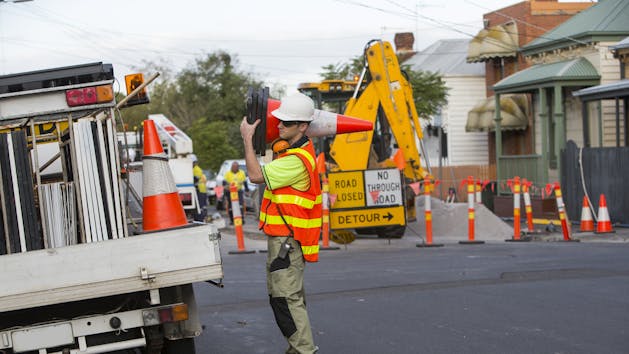Learn how field service organizations are using technology to optimize their fleets and boost their bottom lines while paving the way for their own digital transformations by downloading the Field Technologies Embracing Modern Field Service report.
What is Telematics?
Updated: May 6, 2019
Fleet management is the role in a business that relies on vehicles (and mobile workers) that aims to maximize efficiency, increase productivity and improve safety for vehicles and drivers. Telematics solutions, in many ways, expanded GPS tracking solutions, enables fleet managers to track vehicles, report on fuel consumption, monitor driver behavior and manage vehicle maintenance. Wireless telematics devices and “black box” technologies (the hardware) collect and transmit data from a vehicle or asset back to a platform where this data can be accessed (software).
A combination of telecommunications and informatics, “telematics” is the joining of these two sciences. In its broadest sense, telematics actually includes the internet itself, since it combines telecommunications (phone lines, cables, etc.) with informatics (such as computer systems). However, the term is now more commonly used in reference to vehicle telematics solutions, where, according to Gartner, wireless telematics devices and “black box” technologies collect and transmit data on vehicle use, maintenance requirements or automotive servicing. Here, we will focus on vehicle telematics, as one of the primary uses for this technology, and consider how the technology originated and has evolved over the years.
Telematics: The early days
Telematics actually developed alongside the internet. As computers became smaller and more widespread, the need for an easy way to exchange data grew. This is when telecommunication technology was used to connect computers—telematics was born.
The term “telematics” was coined back in 1978 by Simon Nora and Alain Minc in their report “L'Informatisation de la société,” which was prepared for the French prime minister in response to the development of computer technology and the dawning of the information age.
Since that time, computer processors have become smaller and more ubiquitous, while telecommunication networks have become widespread and effective in transferring data, regardless of where the computer is located. Whether it's on a truck driving through the remotest parts of Alaska or a delivery van in Chile, GPS tracking units with onboard computers can use either GPRS (cell phone networks) or satellite connection to transfer real-time telematics data to central offices for effective fleet management.
Telematics: Today
Today there is practically no limit to the different applications for fleet telematics solutions. The world is becoming more connected every day, and new uses for location-based information are being developed constantly, especially when it comes to vehicle-based businesses.
A popular option for modern-day fleets is to utilize fleet management software (a branch of telematics) to coordinate the hundreds or thousands of vehicles they manage. Everything from fuel consumption to current speed and location can be viewed on a central dashboard. Fleet managers or VPs can get a birds-eye view of the entire fleet, checking the overall health, profitability and productivity of the fleet.
Telematics systems and devices in action
Telematics works when several relevant applications team up to assist with fleet tracking:
- Vehicle tracking: Vehicles can be tracked using a combination of GPS satellites, GPS receivers, GPRS (cell phone) networks and cloud computing. A GPS receiver downloads information on its current location from GPS satellites, processing it for use with applications such as driver GPS navigation, as well as transmitting that information via GPRS to the web servers (cloud computing) used by office-based staff for activities such as dispatching the nearest driver to a new job.
- Trailer tracking: Long-haul fleets often attach GPS trackers to articulated trailers to make sure they don't go missing, and these same devices can route pick-up drivers directly to the stationary trailer. Truck drivers can tag the location in their GPS unit when unhitching a trailer, and those GPS coordinates can be easily passed on to another driver, allowing them to route directly to the trailer. The telematics system can also be set up so that should the trailer be moved without authorization, an instant alert is sent to a fleet manager's mobile device.
- Maintenance improvements: Vehicle maintenance and asset lifecycle management can be improved by using fleet telematics to track hours-of-use records, schedule preventative maintenance, warranty recovery, engine hour tracking and service records tracking. Fleet managers can decrease expenses and keep vehicles in safe operating condition by keeping tabs on engine diagnostics like battery voltage, coolant temperature, powertrain malfunctions, intake valve issues, oxygen sensor problems and more.
- Safety tracking: Fleet management telematics provides a digital blueprint of every aspect of a vehicle’s operation, helping fleet managers understand where improvements can be made in achieving accident prevention measures and driver safety standards. Managers use fleet telematics to monitor vehicle speed and location, as well as contextualizing harsh driving events using features like integrated video. And by leveraging the GPS system in combination with vehicle diagnostics, managers can also remotely track and measure seat belt use.
- Insurance risk assessment: Insurance companies can use telematics to monitor driver behavior, allowing them to more accurately determine their risk factor and adjust their insurance premiums accordingly. Fleet management telematics devices can also report when a vehicle is used in a location outside a designated area (known as a geofence), a capability that is useful in situations such as offering specific 'off-road' farm vehicle discounts.
These are just a few of the many different applications for vehicle and fleet telematics, but it gives you an idea of how technology is being used in practical business applications.
Telematics: The future
Fleet telematics is poised to keep growing exponentially as computer applications are developed to take advantage of the growing number of GPS units, increased processing power and widespread use of mobile devices. Growth since 2007 has been in double-digits as more and more fleets recognize the necessity of monitoring fleet activity closely to control costs and ensure compliance with government regulations. In fact, by 2016 telematics adoption had crept up to 44% and was as high as 78% in the utility fleet industry.1
The future of telematics will largely be determined by the needs of fleet owners who continue to look for ways to cut costs, boost productivity and improve accountability. And as owners look beyond these basic needs to achieve “increasing integrations into the broader scope of the enterprise, including with mobile workforce management, ERP software, and business management software.”2 Vehicle makers are likely to capitalize on this growth by installing OEM telematics systems as they continue to develop smart cars that use telematics technology to deliver better results for customers, and which capitalize on the burgeoning Internet of Things (IoT) landscape to connect vehicles to cities and smart traffic technologies.
Telematics to prime businesses for the future
The successful implementation of telematics systems relies heavily on identifying a solution and customizations and application programming interface (API) integrations that will work together to create the best fit for a business’s unique needs and goals. A robust platform enables fleet managers to track the relevant telematics data that will help increase efficiencies and reduce costs by streamlining process and arming businesses with data.
These reasons are why finding a vendor and solution that can grow with your business. With margins becoming slimmer across all industries, compliance mandates taking center stage and driver and vehicle safety an ever-present concern, the choosing the right technology provider is critical. An experience, resource-rich provider like Verizon Connect benefits customers by offering a full 360-degree view of their fleet’s daily operations, enabling them to dispatch more efficiently, improve customer service and reduce time spent calling drivers for updates.
Discover the robust, customizable telematics solutions available from Verizon Connect and how we can help businesses like yours go further.
Sources
1 https://www.truckinginfo.com/138340/report-finds-fleet-telematics-adoption-steadily-increasing
2 https://www.automotive-fleet.com/320583/looking-ahead-to-2019-the-future-of-telematics
Find out how our platform gives you the visibility you need to get more done.




